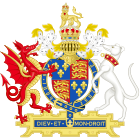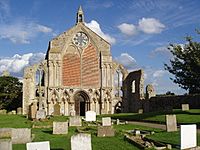Suppression of Religious Houses Act 1535 facts for kids
| Act of Parliament | |

|
|
| Long title | An Acte wherby all Relygeous Houses of Monkes Chanons and Nonnes whiche may not dyspend Manors Landes Tenementes & Heredycaments above the clere yerly Value of ij C Li are geven to the Kinges Highnes his Heires and Successours for ever. |
|---|---|
| Citation | 27 Hen. 8. c. 28 |
| Other legislation | |
| Repealed by |
|
|
Status: Repealed
|
|

The Suppression of Religious Houses Act 1536 was a very important law passed by the Parliament of England in February 1536. It is also known as the Act for the Dissolution of the Lesser Monasteries. This law was the first step in King Henry VIII's plan to close down many religious houses, like monasteries and priories, across England. This big event is called the Dissolution of the Monasteries.
Contents
Why the Act Happened
For a long time, even before King Henry VIII, some popes had allowed religious houses in England to be closed. For example, in 1528, Cardinal Wolsey took money from Rumburgh Priory to build a college.
King Henry VIII and the Church
King Henry VIII had a big disagreement with the Church in Rome. This started because he wanted to marry Anne Boleyn. In 1533, a law called the Statute in Restraint of Appeals was passed. This law stopped people from appealing to the Pope in Rome about religious or other matters.
The Pope, Pope Clement VII, reacted by saying Henry was temporarily removed from the Church. This made the King and the Pope even more hostile. People at the time believed that monks were not fully loyal to the King. They thought monks might side with any foreign power that attacked England, especially since the Pope had removed Henry from the Church.
Also, King Henry needed a lot of money. People in England wanted to save their own money. So, a suggestion was made in Parliament: give all religious houses that earned less than 200 pounds a year to the King. This Act was passed in March 1535 (or 1536 by modern calendar).
Checking the Monasteries
After King Henry took control of religious matters, he sent people to check on the monasteries. He appointed Thomas Cromwell, a layman, to be his main representative for spiritual affairs. Cromwell's job was to visit the monasteries and make sure they followed the new rules.
Cromwell used special helpers, mainly Richard Layton and Thomas Leigh, to do these visits. They worked very quickly. They visited houses in the west of England first, then the east and southeast. By January 1536, they had reached York in the north.
Parliament met on February 4, 1536. They received a summary of a report called Valor Ecclesiasticus. This report was a survey of how much money the monasteries in England had. Cromwell's original plan was to reform the monasteries, but Parliament decided against it. Instead, a new plan to close them down, suggested by Thomas Audley, was passed as this Act.
The Act only applied to smaller religious houses. These were houses that earned less than 200 pounds a year from their lands and other income. The Act claimed these smaller houses were full of bad behavior. It suggested that the people living there should be moved to larger, more respected monasteries. There, they would be "compelled to live religiously."
What the Act Said
The introduction to the Act explained why it was needed. It said:
"There is much clear sin and bad living happening every day in the small abbeys, priories, and other religious houses of monks, canons, and nuns. These are places where there are fewer than twelve religious people. The leaders of these houses, and their groups, are ruining and wasting their churches, monasteries, and lands. They are also wasting their church decorations and goods. This greatly displeases God, harms good religion, and brings shame to the King and the country.
Even though many visits have been made over the past two hundred years to fix this bad living, little or no improvement has happened. Instead, their bad behavior shamelessly grows. It is so deeply rooted that many religious people in these small houses would rather wander off than follow good religious rules. So, unless these small houses are completely closed down, and the religious people moved to larger, respected monasteries in England where they can be made to live religiously, there will be no way to fix the problem."
What Happened Because of the Act
The main result of this Act was that the King took over the smaller religious houses. The Act stated that the King and his future heirs would own all monasteries, abbeys, and priories. This included any that had already been given to the King by their leaders or had been closed down in the year before the Act was made. The King could then do whatever he wanted with these properties and their wealth.
This part of the Act also made legal any closures of monasteries that had already happened before the Act was officially passed.
The Aftermath: Rebellions
This Act, and the many closures that followed, caused a major rebellion. It was called the Pilgrimage of Grace. This uprising began in Louth, Lincolnshire, in October 1536. About 30,000 men joined the rebellion.
King Henry ordered his commanders, like the Duke of Norfolk and Lord Shrewsbury, to stop them. But the King did not have a permanent army, and many people supported the rebels. So, Henry had to negotiate for peace. He agreed to some of their demands, including bringing back the monasteries. He also promised to call a new Parliament and give the rebels free pardons.
However, after the rebels went home, Henry broke his promise. The leaders of the rebellion were arrested and put on trial. Several hundred people were executed. Another smaller rebellion, called Bigod's rebellion, followed, but it also failed.
The Act is Removed
Over time, parts of this Act were removed by other laws. Sections 17 and 18 were removed in 1623. Later, in 1948, sections 4 to 6, 8 to 12, and 14 were removed. Finally, the entire Act was officially removed by the Statute Law (Repeals) Act 1969. This means the law is no longer in effect today.
See also

